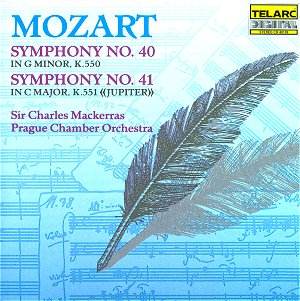Telarc, as well as marketing Mackerras's Mozart
cycle as a box, also keep the individual CDs on tap - dropping
them to midprice. These are the same CDs as originally issued
in the 1980s at full price. This one, for example, bears a copyright
date of 1986, just three years after the launch of the compact
format.
The music is well known. The catalogue bristles
with competition. Mackerras is complemented by Telarc's best sonics,
matching vibrant sound with splendidly tense playing. Mackerras's
Mozart is no friend to languour - more Lamborghini than Mondeo.
Note writer William Malloch points out that Mackerras's tempi
are not up to the break-neck pace recommended by Hummel and Czerny.
Even so he keeps things taut and springy throughout. Small touches
such as the little hiccuped cries at 00.43 and 00.47 in the K550
andante indicate finely chased detailing. Despite his speedy tempi
poetry is given its head as in the allegro assai of K550.
High speed is also a charatceristic of K551. It is a tribute to
the Prague Chamber Orchestra that they keep up and do not collapse
into gabble or chaos. Fine airy, performances, phrases sharply
accented, Mozart completely purged of powdered wig lassitude.
The PCO sounds like a big band without the crushing weight of
the VPO for Böhm or the Berlin Phil for Karajan. Even so
there are only twenty-five players using modern instruments. The
PCO’s violins are silk rather than sackloth. The timpanist uses
wooden sticks as a concession to Mozart's era and the second violins
are placed to the right of the conductor in a typical Boult and
Handley layout.
This is lovely playing standing halfway between
full cream deep pile grand orchestral style and HIP 'authenticity’.
Speeds will disconcert some though Mackerras yet finds tenderness,
triumph and terpsichore in these two Apollonian symphonies.
Rob Barnett
